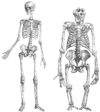Gibbon–human last common ancestor
Not to be confused with Hominoidea.
| Gibbon–human last common ancestor Temporal range: 17.6–15.9 Ma | |
|---|---|
| Scientific classification | |
| Kingdom: | Animalia |
| Phylum: | Chordata |
| Class: | Mammalia |
| Order: | Primates |
| Infraorder: | Simiiformes |
| Superfamily: | Hominoidea |
| Type species | |
| Homo sapiens Linnaeus, 1758 | |
| Genera | |
|
Family Hylobatidae
Family Hominidae | |
The gibbon–human last common ancestor (GHLCA, GLCA, or G/H LCA) is the last species that the families Hominidae and Hylobatidae (i.e. the orangutan–gorilla–chimpanzee–human last common ancestor on one hand and gibbons on the other) share as a common ancestor. It is estimated to have lived 15.9 to 17.6 million years ago (TGHLCA) during the early Miocene.[1]
References
- ↑ Carbone, Lucia; et al. (2014). "Gibbon genome and the fast karyotype evolution of small apes". Nature. 513 (11 Sept 2014): 195–201. doi:10.1038/nature13679.
See also
- Chimpanzee–human last common ancestor
- Gorilla–human last common ancestor
- Orangutan–human last common ancestor
- History of hominoid taxonomy
- List of human evolution fossils (with images)
| Wikispecies has information related to: Hominoidea |
This article is issued from Wikipedia - version of the 11/12/2016. The text is available under the Creative Commons Attribution/Share Alike but additional terms may apply for the media files.
